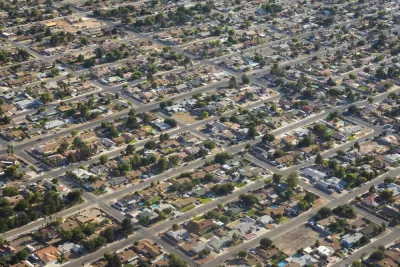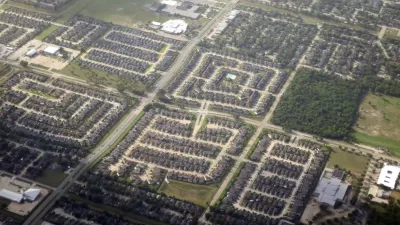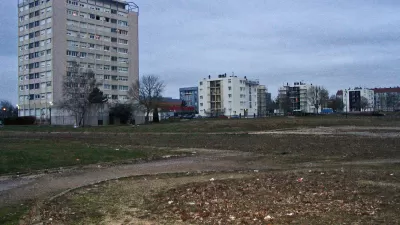American suburbs are growing, and understanding the evolution of suburban sprawl is a useful guide for the future.

[Updated 11/19/2018] In a piece written for his new book, “The Urban Fix: Resilient Cities in the War against Climate Change, Heat Islands and Overpopulation,” Doug Kelbaugh reflects on the history of suburban sprawl and the challenges its continued growth brings.
Kelbaugh isn’t a fan of suburbs — he refers to suburbia as a virus — and he draws from the writings of various academics and journalists to look back at the spread of modern suburbs in the United States, starting after World War II. Suburbs were not only heavily subsidized notions of the American Dream, says Kelbaugh; they were also an attack on nature. “It’s tragic that America not only smeared the suburban compromise of town and country across its 50 states, but it also exported it a world only too happy to embrace the seemingly happy lifestyle they’d seen in the movies and on TV,” he laments.
He continues through the many problems with suburbs. They are unsustainable by encouraging auto dependence, low density, big houses, and environmentally unfriendly lawns. The architecture is soulless. The parking lots are expansive. The intersections are too big. “This is the land of big asphalt, which absorbs solar radiation and creates heat islands even in low-density suburbia,” Kelbaugh notes.
But while cities offer more of what millennials want, they still are moving to the suburbs. Kelbaugh, however, thinks millennials will drive the transformation of suburbs with their desire for more sustainable communities:
Drone deliveries, ride-sharing, car-sharing, AVs that park themselves and connect to house lights and thermostats will be commonplace, as will up to a 50 percent reduction in paved area. Less hardscape won’t be difficult, given the absurdly wide streets in contemporary subdivisions. There will be fewer fences and more common land for recreation, gardens, ponds, woods and wetlands.
The environmental issues with suburbs — the heat, the consumption of precious resources, the air pollution — make reining them in a global concern, says Kelbaugh. Particularly in developing countries with fast-growing metropolises, he believes containing sprawl is imperative in maintaining the quality of life of residents in highly populated areas.
FULL STORY: Reconfronting sprawl: Still paved with good intentions and asphalt

Manufactured Crisis: Losing the Nation’s Largest Source of Unsubsidized Affordable Housing
Manufactured housing communities have long been an affordable housing option for millions of people living in the U.S., but that affordability is disappearing rapidly. How did we get here?

Americans May Be Stuck — But Why?
Americans are moving a lot less than they once did, and that is a problem. While Yoni Applebaum, in his highly-publicized article Stuck, gets the reasons badly wrong, it's still important to ask: why are we moving so much less than before?

Research Shows More Roads = More Driving
A national study shows, once again, that increasing road supply induces additional vehicle travel, particularly over the long run.

Judge Halts Enforcement of Anti-Homeless Laws in Grants Pass
The Oregon city will be barred from enforcing two ordinances that prosecute unhoused residents until it increases capacity and accessibility at designated camping sites.

Advancing Sustainability in Los Angeles County Schools
The Los Angeles County Office of Education’s Green Schools Symposium brings together educators, students, and experts to advance sustainability in schools through innovative design, climate resilience strategies, and collaborative learning.

Using Old Oil and Gas Wells for Green Energy Storage
Penn State researchers have found that repurposing abandoned oil and gas wells for geothermal-assisted compressed-air energy storage can boost efficiency, reduce environmental risks, and support clean energy and job transitions.
Urban Design for Planners 1: Software Tools
This six-course series explores essential urban design concepts using open source software and equips planners with the tools they need to participate fully in the urban design process.
Planning for Universal Design
Learn the tools for implementing Universal Design in planning regulations.
City of Moreno Valley
Institute for Housing and Urban Development Studies (IHS)
City of Grandview
Harvard GSD Executive Education
NYU Wagner Graduate School of Public Service
City of Cambridge, Maryland
Newport County Development Council: Connect Greater Newport





























